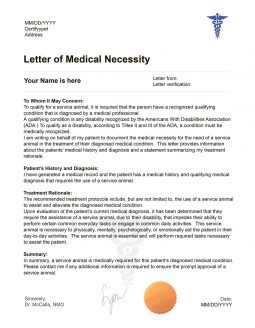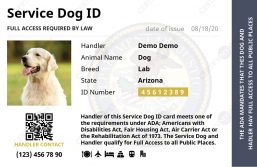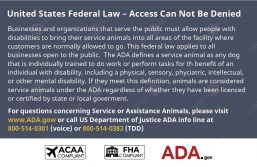It is any disability recognized by the Americans With Disabilities Association (ADA.) To qualify as a disability, according to Titles II and III of the ADA, a condition must be a medically recognized physical, psychiatric, sensory, intellectual, or other mental disability. ADA’s definition of a disability may be different from the definition other agencies and organizations utilize. For instance, the ADA’s definition of a disability is different from the one the Social Security Administration (SSA) uses to determine benefits.
What Medical Conditions Qualify
for a Service Dog?
- Allergies
- Anxiety disorders
- Chronic pain
- Asthma
- Autism
- Diabetes
- PTSD, Post-traumatic stress
- Problems with speech
- Social anxiety and phobias
- Other physical and mental disabilities
If you find limitations in your sight, hearing, eating, standing, walking, sleep, speech, or cognition (or ability to think) that impede your ability to perform certain everyday tasks, you may have a disability that would qualify you for a service dog.

Real Life Stories
What are the Service Dog Requirements
for Documentation?
There are no service dog certification requirements. That is, no documentation whatsoever, not proof of training, licensing, certification or disability, is required to have a service dog. A person cannot even ask you if you have a disability or what tasks a service dog performs for you. You might be asked those questions if your disability is not obvious.
If you are missing a formal diagnosis, don’t have insurance etc you can get treatment from one of the physicians provided by Certifymypet.com
Medical Records
The documentation most helpful in demonstrating your qualifications for a service dog is an official letter from a doctor licensed to practice medicine in your state containing the following information:
The fact that you have a disability (though any information about the disability can, and should, be kept private.)
The fact that the disability impairs your ability to perform certain common everyday tasks or engage in common, daily activities
The fact that, according to the doctor, a service animal would be helpful in performing those tasks and activities so that you can meet those daily needs.
Service Dog ID Card
Certifications, IDs and registrations do not convey any rights under the ADA and government organizations do not recognize them as proof that the dog is a service animal. Unfortunately, staff at many public establishments will still insist on IDs or other tangible proof of service dog status.
For convenience, privacy, and to set proper boundaries with strangers, some service dog owners find it helpful to own documents and accessories that can help signal that their dog is a trained service dog. This will help prevent situations where you are met with hostility or confusion when traveling with your service dog. Electing to carry a custom Service Dog ID may be helpful tool for you and your service dog to navigate public spaces.
How Does a Dog Become a Service Dog?
The key to making a pet dog into a service dog is training. The dog can be trained to perform particular task that both help a person with a medical condition and are directly related to that medical condition. You can hire a dog trainer or even self train your dog in many cases.
Determine the Type of Dog You Have or Desire as a Service Dog.
If you don’t already have a dog you’d like to make into a service dog, the first step to getting a service dog is to select a dog. Choose what type of dog you want before you go searching for dogs. Otherwise, you may fall in love at first sight with a dog that’s not as suitable for your needs. Consider the full range of factors involved in owning a service dog when choosing what type of dog you’d like to have as your service dog, including:
Your disability – You need a service dog capable of performing the tasks you need the dog to perform for you. A person in a wheelchair, for example, doesn’t want a service dog too small to pull the wheelchair around. A person who travels by plane often, on the other hand, might not want a dog too large to fit comfortably in cabin (though all domestic flights are required to accept service dogs of any size in cabin.)
Your lifestyle – You need a service dog that can easily conform to your current lifestyle. If you live in a city apartment without a yard, for example, a dog with a lot of energy that needs frequent exercise may not be a practical choice of service dog. If you live alone and cleaning is difficult for you, a long-haired service dog that sheds everywhere all the time may be an impractical choice for you.
Your tastes and preferences – Ultimately, you want a service dog that will be with you for a very long time. You, therefore, want a dog you can feel close to and form a bond with. In short, you should like the dog. If there are certain breeds of dogs you’re not fond of for one reason or another, avoid choosing that breed as your service dog.
As you consider these factors, you’ll start to hone in on the size and type of dog you want and the best breed or breeds of that kind.
Also integral in selecting a dog to be your service dog is ensuring the dog is capable of being a service dog. Dogs that are too old may not be as trainable at that age, or they may simply be incapable of carrying out the duties required of them. Moreover, if your dog is too old or is prone to getting sick all the time, you’ll find yourself in a situation where it’s you serving your service dog instead of the other way around. By the same token, a dog too young to be controlled won’t make a good service dog either. If a puppy is hyperactive or not housebroken, it might be too soon to make that puppy your service dog. It’s the perfect age, however, at which to start training a dog to be a great service dog when older. Generally recommended is waiting until a puppy is at least 6 months old before considering the puppy as a possible service dog.
Finally, you want a service dog that is healthy enough to perform the regular duties of a service dog. Therefore, once you’ve identified a dog you’d like to be your service dog, take that dog to a veterinarian for a full checkup, including bloodwork, to make sure the dog possesses no underlying conditions that could impact the dog’s ability to be an effective service dog. If the dog turns out to have a health concern like diabetes or arthritis, you might want to reconsider having that dog be your service dog. Once you select your service dog, incidentally, you should also take the dog to the vet at least once a year for regular checkups to make sure the dog is still healthy and fit. It is recommended service dogs all be spayed or neutered in order to reign in any aggressive tendencies in the males and eliminate the need to make females work while in heat.
If you already have a dog as a pet or another dog in mind, such as a family member’s pet, you want to ask yourself if that dog is actually qualified to be a service dog or if choosing that dog is simply convenient. Ask yourself if that dog fits the needs of your disability and your lifestyle, is of an acceptable age and level of health and if the dog has the right personality and behavior traits for a good service dog.
Determine Whether to Train Your Service Dog Yourself or Locate a Qualified Service Dog Trainer
Once you select a dog to be your service dog, it’s time to get that dog trained to perform the tasks you need the dog to perform. You can choose to either train your service dog yourself or hire a professional service dog trainer to do it for you.
If you choose to train your dog to be a service dog yourself, keep in mind that it will require a lot of you, in terms of patience, persistence and calm.
If you choose to have your dog trained professionally to be a service dog, you can rest assured that the community of service dog trainers have developed minimum standards they use to self-regulate their training activities. You can read more about these standards in the next section below.
There are several fine places to find expert professional service dog trainers, including Assistance Dogs International, the recognized worldwide authority in service dog training.
When evaluating a service dog trainer or training program, there are several criteria to consider, including the following:
Location – How far are you willing to travel to visit the trainer or organization and retrieve your service dog once training is completed?
Reputation – How many service dogs has the trainer or organization successfully trained? Do they have references or testimonials you can check?
Selection – If you’re getting your dog from the training organization or trainer, do they select your service dog for you or do you? What is the health and parentage of your service dog? How healthy are the parents and litter mates? Are health screenings conducted on potential service dogs?
Focus on you – Even though a service dog trainer or training organization works mainly with the dog him or herself, the client is you. A trainer or training organization should take every step to ensure that your medical condition and service dog training needs are met. The best service dog trainers will have you and your health care team fill out detailed forms describing not just your disability but your lifestyle and personality as well. They will inquire as to how you spend your days and nights, and how your disability affects you in those situations. They will ask about your living space and workspace and about your activities outside of the home. If you have your trainers select your service dog for you, this is one of the ways they will best be able to match you with the right breed, size and temperament of service dog for you.
Follow-up – Does the trainer or service organization offer follow-up training if needed? Service dog trainers should be available by phone or email to answer questions and provide guidance or support for a reasonable length of time after training is completed and you and your service dog have begun life together. They should even be willing to provide short-term training reinforcements to help deal with problems, if they develop, or if your disabilities advance.
In addition to these factors indicating a quality service dog trainer or training organization are several red flags to look out for to steer you away from service dog training scams or, simply, subpar trainers. These include failing to provide direct answers to your questions, refusing to let you examine training or veterinary records of the dog selected for you, refusing to let you visit the training facilities or speak with individual trainers and failing to make follow-up training support available to you after your service dog returns home with you.
Train Your Dog to Be a Service Dog
Whether you train your service dog yourself or hire a professional to train your service dog for you, your dog should be trained in the same basic commands.
The United States has not defined any service dog training standards, but there are international guidelines many smart trainers and service dog owners and handlers abide by. International service dog training standards require at least 120 hours of training over a period of six to 24 months. Moreover, a minimum of 30 of these 120 hours must be spent out in public confronting the possible situations, circumstances and surprises your service dog is likely to encounter while out and about you on a daily basis.
Over the course of these 120 minimum hours of training, your service dog will learn three categories of skills, as listed, in order, below this paragraph. These skills are best taught in consecutive order, only proceeding to the next category once the dog has adequately learned and assimilated the previous category. That way, you avoid overloading the dog and leading the dog to forget skills not sufficiently assimilated before moving on to the next skills and/or causing the dog stress or anxiety.
To heel – A skill requiring much more nuance than sitting or coming, heeling can be hard for some dogs to learn. The key is to train the dog to maintain a set position relative to you at all times, no matter how you move. Changing paces, directions, and stopping to both sit and stand still are all helpful elements to incorporate into this phase of the training.
To proof – Depending on how easily distracted the dog is will determine how time-consuming this phase of the training is likely to be. Proofing, simply put, is teaching the dog to execute the same commands in different situations. Dogs do not extrapolate well, meaning if they learn a skill in one setting or situation, that doesn’t mean they will necessarily perform that skill in a different situation or setting. Training a dog to heel in your yard or neighborhood, then, doesn’t necessarily mean your dog will heel in the park or the subway station or the grocery store. To be sure your service dog can execute the commands required of him or her in any setting, you must proof the dog, or train him or her to perform those same tasks in those other settings.
To task – While proofing can be the most time-consuming of the three phases of training a service dog, this third and final phase can be the hardest. For, in addition to the basic obedience commands required of any service dog, your service dog must also be trained to perform the specific tasks you need the dog to perform to help you with your disability. This is obviously different for every service dog and owner or handler.
Consider Service Dog Registration and Certification
While you do not need to register or certify your service dog in order to have one and enjoy all the rights granted to you and your service dog under the ADA, FHA, ACAA and other applicable laws, nor can a city or any other entity require that you register or certify your service dog as a service dog, it can be quite beneficial for you to consider doing so. (Note that localities can, and generally do, require you to license your service dog as a dog residing in that locality, and this is a requirement by which you must comply.)
Certifymypet offers complete all-in-one service dog registration and certification services. In as easy as 1-2-3, you can qualify for a service dog, get your service dog and register your service dog. Read more about how below:
Qualify for a Service Dog – Certifymypet will set you up on a teleconference with a doctor licensed in your state to discuss your disability and need for a service dog with you and provide you the documentation you need to move forward in getting a service dog with confidence and peace of mind.
Get Your Service Dog – Once you’ve qualified for a service dog, you’re ready to get your service dog. You can either make your own dog into a service dog or obtain a dog already trained as a service dog for your disability. Either way, Certifymypet can help. Through our expert guides and the Certifymypet Blog, you can learn everything you need to know about making your dog a service dog or getting a trained service dog. You’ll learn where to look, what to look for and what to avoid.
Register Your Service Dog – When you sign up at Certifymypet, you get all the benefits of service dog registration, including:
Doctor’s letter – After an appointment by teleconference with a physician or psychiatrist, depending on your disability, licensed to practice in your state during which you will demonstrate your service dog qualifications, you will receive an official, valid and legitimate doctor’s letter stating that you have a disability recognized by the ADA, that a service dog can help you with this disability and that you have a service dog performing these very duties for you. What this letter will not state is any personal or private information such as what your disability is or how it affects you.
Identification – You may not need identification to prove you have a disability and that your dog is a service dog, but it sure can help. With Certifymypet service dog registration, you get a whole bunch of identification to use if and when you feel it’s appropriate. These include a service dog harness and vest with a pocket for an ID card, also provided, that identifies your dog as your service dog. Are service dogs required to wear a vest? No, they aren’t, but it can keep you from being bothered by people who think you’re trying to bring a pet into a pet-free zone. With Certifymypet service dog registration, you also get waterproof, wear-proof and weatherproof PVC (polyvinyl chloride) ID cards for your wallet or purse identifying you as a person with a disability authorized under the ADA to have a service dog. Not only do these cards contain essential info an individual could utilize to verify your claims of qualification for a service dog, but they also contain information that helps to educate and inform individuals unfamiliar with the laws regarding service dogs. If you lose any of these cards, you can receive replacements for as long as your Certifymypet service dog registration remains active.
Registry and Verification – For as long as you subscribe to Certifymypet, you’ll have an active listing for you and your service dog in a digital registry. Then, whenever you encounter someone questioning your right to access a space or services with your service dog, you can have them call a toll-free number or go online to have a trusted Certifymypet agent securely and confidentially provide the verification required.
Get Approved in 3 Easy Steps 100% ONLINE
02.Step

03.Step

(Instant PDF + original hard copy 2 business days)








